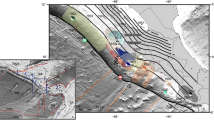Abstract
On August 21st and 22nd 1856, two strong earthquakes occurred off the seaport of Djidjelli, a small city of 1000 inhabitants, located 300 km east of Algiers (capital of Algeria). In relation to these two earthquakes, an important tsunami (at least one) affected the western Mediterranean region and the eastern Algerian coastline between Algiers and La Calle (Algero-Tunisian border). Based on historical information as well as on data recently collected during the Maradja 2 survey conducted in 2005 over the Algerian margin, we show that the tsunami could have been generated by the simultaneous rupture of a set of three en echelon faults evidenced off Djidjelli. From synthetic models, we point out that the area affected along the Algerian coast extended from Bejaia to Annaba. The maximum height of waves reached 1.5 m near the harbor of Djidjelli.
Similar content being viewed by others
Author information
Authors and Affiliations
Corresponding author
Rights and permissions
About this article
Cite this article
Yelles-Chaouche, A., Roger, J., Déverchère, J. et al. The 1856 Tsunami of Djidjelli (Eastern Algeria): Seismotectonics, Modelling and Hazard Implications for the Algerian Coast. Pure appl. geophys. 166, 283–300 (2009). https://doi.org/10.1007/s00024-008-0433-6
Received:
Revised:
Published:
Issue Date:
DOI: https://doi.org/10.1007/s00024-008-0433-6




